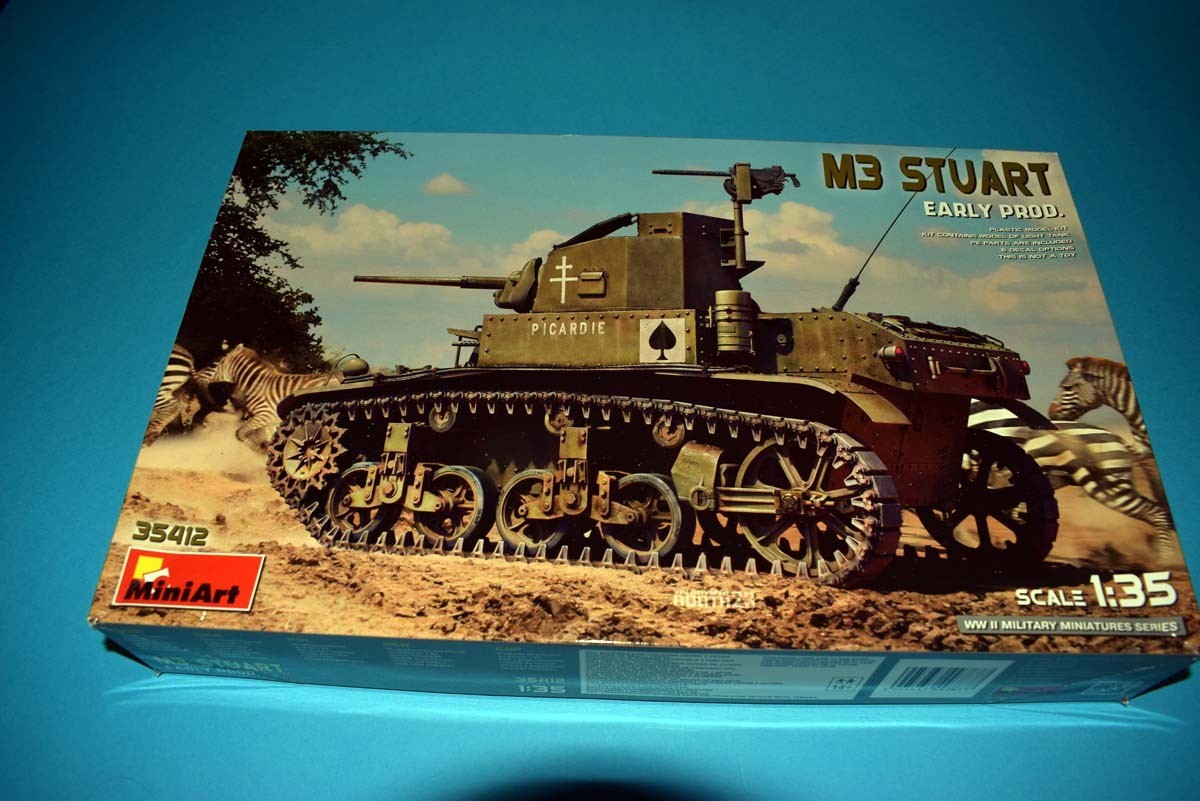
Review
This offering from MiniArt further increases their line of M3 Stuart tanks, with this one being a early model without an interior. The model arrives in a cardboard tray with a separate card lid. The contents, with the exception of the instruction booklet are all packaged within a single plastic bag - including what has become my pet hate of packaging the decal sheet with the clear sprue. An examination of the sprues reveals no issues with regards to moulding quality. The gates between the parts and sprue are of a reasonable size, with good access for removal but are excessive in number on some parts. The usual warning applies - which is to be careful while removing the parts from the sprue especially where the finer mouldings are concerned.
Due to MiniArt releasing a whole family of Stuarts, both with and without interiors the exterior parts of the model have interior detail on them and the hull of the model is made up of a series of flat panels. The method used has enabled MiniArt to include a very good level of surface detail on the model parts. Assembly of the hull could prove to be difficult, but in this case has been aided with locator points where the wheel assembly cross members are and the inclusion of a firewall that would go between the crew and the engine. This enables you to be relatively happy that all surfaces are accurately attached. The rear of the tank has the access hatches for the engine bay which are very nicely detailed in all aspects. Photo etch within this model is liberally applied and there are some very fine elements that are used. I have not observed any photo etched parts that look to be un-necessary included. It does, however, mean that this model is definitely not shake and bake but is instead a challenging offering with an exceptionally high level of detail. Some of the aspects that mark this out as an early production are the locations of the hull machine guns, and these have been very well detailed both inside and out due to the previously mentioned interior model offerings. One item that I have noticed is the requirement to shave 8 bolt heads off of one of the sprues and attach them around the turret ring, which for me would prove to be very difficult due to the hands and eyes not being as they were.
The suspension units of this offering are very highly detailed, and I cannot see any improvements that are needed in the area, even the area replicating the rubber portion of the road wheels has manufacturing details on it. I suspect that some may complain that the suspension cannot be manipulated, however this is a unwarranted concern as the tracks provided in the release are link and length offerings and this has enabled the high level of detail demanded by modellers these days while providing the modeller with a task of assembling them that is not as intensive as individual track links.
The turret of the model is the same as the lower hull and made up of a series of flat panels. Some locator points have been placed on the turret ring base to enable accurate placement of the turret sides. The main gun is very well detailed both inside and out, as is what I refer to as the ranging machine gun. Meaning that if you have the turret hatch open there is something inside to see regardless of how the figure is positioned in the turret. Clear observation ports are included for the turret, and which surround the very large opening in the turret roof. This raised area on top of the turret is another aspect that marks an early vehicle. A very nice exterior mounted 30 cal Browning machine gun mounts on a support, behind the Commander’s access hatch but would only be of any use if attacked from behind or firing from outside of the vehicle.
Some areas that I have skipped over, that need to be mentioned are exterior detail such as the mounted tools and the aerial mounts. The aerial mounts are provided as part of the model, and have pretty good detail to them. You need to make you own aerial, but I commend MiniArt for having provided the length required for the aerial and so removing all that guess work or questions. The tools themselves have moulded on clamp detail, but are very crisp in their appearance with the leather buckled straps being particularly nice detail. The tow cable has eyes provided in the model and photo etch tie down straps included. You need to decide what you want to use and there are some excellent options out there for replicating twist cables.
MiniArt has provided 6 finishing options for this release. These are:
192nd Tank Battalion. Philippines, Luzon, December 1941
2nd Independent Tank Company, Free French Forces. Kano, Nigeria, 1942
American Car and Foundry Plant, 1000th Tank
192nd Tank Brigade, Red Army. Volkhov Offensive, ORYOL Region, Summer 1942
US Marine Corps. Australia, Spring 1943
Brazilian Army, 1944
Conclusion
This offering from MiniArt has a lot going for it in certain areas, and my complaints I will restrict to the packing of decals with clear sprues. The highs that stand out for me, are both the main and secondary weapons, the tools as regards the clamp detail, the aerial detail and including data on the rubber areas of the wheels. Lastly, I highly commend MiniArt for covering such as broad range of finishing options, both as regards country of use and location where being used. All of this for me makes this a great all rounder kit for the modeller who wants to build something different, while not stepping away from their area of interest.

